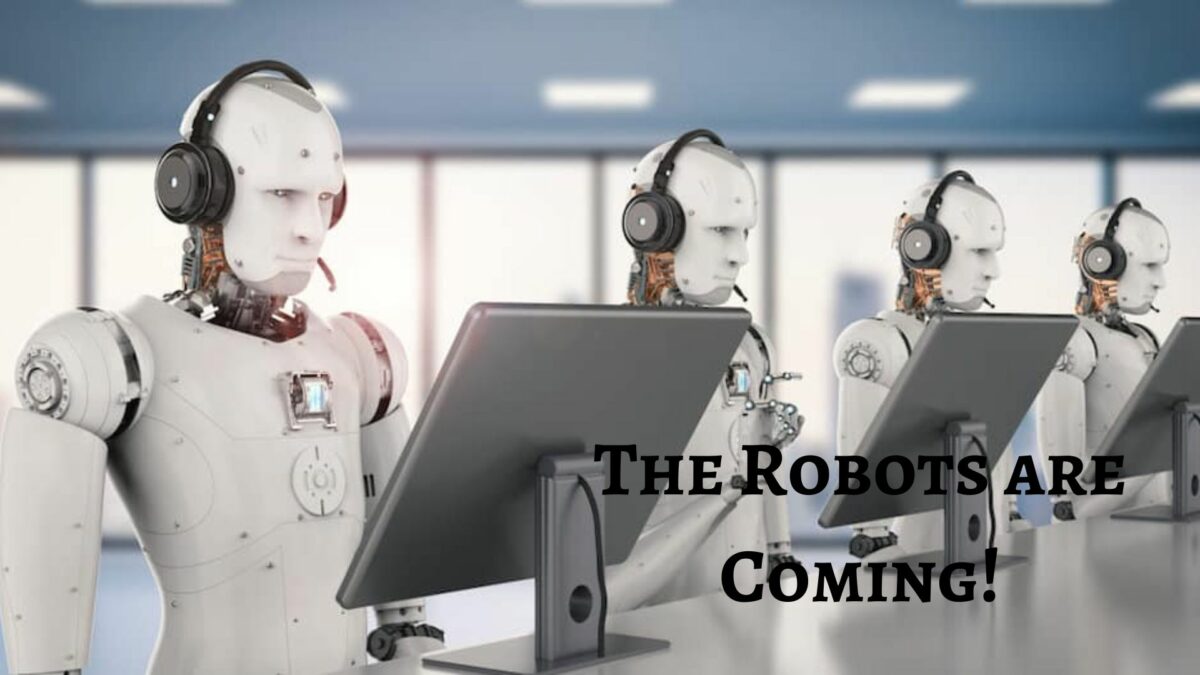Some Google employees have their self-driving vehicles take them to work. These car robots don’t look like something from ‘The Jetsons’; the driverless features on these cars are a bunch of sensors, wires, and software. This technology ‘works.’”
–Tyler Cowen

This post started out with an innocent enough tweet. I had seen an advertisement from Ford about a self-driving car of the future. While, naturally, I couldn’t find that exact advertisement on the Internet, I found something similar:
The picture in the advertisement was of a couple sitting in the front seat of their self-driving vehicle, chatting idly away while the car whisked them off to wherever it was that they were heading. They seemed engrossed in their own conversation, completely oblivious to whatever lay ahead in the road, which led me to wonder:
Do self-driving cars repair their own flat tires?
— Jason Hull (@hull_j) April 6, 2017
The tweet got a couple of likes and retweets, but no serious answers.
It’s not the first time I’ve wondered about robots doing the work of humans:
How long will it take to go from robot bricklayer (https://t.co/jY6Jo01JtP) to complete automated building construction?
— Jason Hull (@hull_j) September 13, 2016
I live in a downtown urban area. I am at the point where I rarely drive. I’m a big user of Uber, or, secondarily, Lyft to get me somewhere around town if public transportation isn’t convenient. I happily use Megabus or Amtrak to get to other places that aren’t within flying distance. Gone are the days when I enjoyed 5-6 hour one-way trips when I was in college or stationed in Germany to get to far flung places.
In fact, urban living tends to breed its own version of laziness. Even though the nearest grocery store is less than a mile away, it’s across a major highway and the parking lot is always full, creating, in my mind, unnecessary hassle (yes, I know…#firstworldproblems). When we moved to our current location, there was a grocery store a block away that we walked to. It also had a growler bar, so we could always get a glass of wine or beer to put in the cart while shopping. Seemed like we always came home with more than we expected on those trips…hmm…
So, because of my decreased driving – a positive in my mind because it creates the corollary of increased walking – I’ve become fascinated by self-driving cars. I firmly believe that self-driving cars are not too far in our future (see the great Wait But Why series on Elon Musk to get a good overview of where this technology is heading), and that will have an astonishing impact on people who depend on driving to get something or someone from point A to point B, both as employees and as consumers.
I dream of the day when I can log onto Amazon (#aff), make my order of weekly grocery delivery, and have a self-driving car deliver it to my residence.
But, it’s not just grocery shopping where this could possibly occur. In Dallas (and probably other places), there’s a service called Favor where you can order foods from different restaurants, and a driver will go and fetch those orders for you. On binge day, we love to get i Fratelli pizza and Val’s Cheesecakes (if you’re in Dallas and haven’t tried Val’s, you’re missing out on a treat). As it works now, the app sends orders to both places, and then a driver goes to both places, picks up the items, and delivers it to our location.
With robots and self-driving cars, though, all of these processes could be automated. From stocking the shelves in the grocery store to making the pizza, we are probably not far away from having machines do those jobs. I can envision a robot pulling items from the warehouse (many years ago, eToys had a similar system, using RFID and bar code scanners to fill orders in a nearly completely automated manner), then putting the order into a segmented off truck a la Door to Door Organics (oops…since closed!) (note: I am a minor investor in the predecessor company, Relay Foods) that is self-driving, and then having that truck make the rounds until it got to my place to deliver the goods.
It’s easy to extend this notion out not only to shopping, but to shipping in general. Load up 18-wheelers, and send them on their way, with no drivers. Were I one of the 3.5 million truck drivers on the road in the U.S., this would send me scrambling to get educated in a field that wasn’t such a potential commodity.
However, these visions aren’t quite as around the corner as we might think. Look at a Roomba (#aff). It can happily run around your floors, vacuuming to its heart’s content, scaring the dog and entertaining the cat. When it runs out of steam, it heads back to its home base for a recharge. It’s semi-autonomous; however, it still needs human intervention. When it’s filled to the brim with dog hair and dust bunnies, it needs a human to empty it. When something other than a discharged battery happens, the human has to send it back to the manufacturer for repairs.
Until these robots can fix themselves, there’ll be need for human intervention. Perhaps when the flat tire that I mentioned in my first tweet occurs, there will be on demand mechanics, just like AAA, except driven by self-driving cars. The car can send out a SOS with a self-diagnostic of the problem, and the mechanic will be automatically dispatched to correct the problem.
It’s quite possible that we’ll continue to automate and revolutionize human processes to the point where we become a world without work. As great as industrial automation, home robots (hello, Echo (#aff)!), and self-driving cars might be, there’s still a lot of room for innovation in tying everything together.
But, in this future leisure-filled world where robots do a lot of the work, and we often will have no incentive to get outside and socialize, will we create utopia or dystopia? I work predominantly from home, and there are stretches where I go for days without leaving the apartment except to walk the dog, so the only people I see are my wife (who has to put up with me all of the time) and the people I encounter on the dog walk. I readily tend towards the path of least resistance, so when automation reduces the costs of services to bring to my doorstep the things that I would otherwise have to drive to procure (which, admittedly, are much fewer with Amazon Prime (#aff)), will I become a hermit? Or will the reduction of the need to tie myself up driving to places free me to do more valuable things, to connect more with friends, and to become a better global citizen? I don’t know the answer.
Author Profile
- John Davis is a nationally recognized expert on credit reporting, credit scoring, and identity theft. He has written four books about his expertise in the field and has been featured extensively in numerous media outlets such as The Wall Street Journal, The Washington Post, CNN, CBS News, CNBC, Fox Business, and many more. With over 20 years of experience helping consumers understand their credit and identity protection rights, John is passionate about empowering people to take control of their finances. He works with financial institutions to develop consumer-friendly policies that promote financial literacy and responsible borrowing habits.
Latest entries
 Low Income GrantsSeptember 25, 2023How to Get a Free Government Phone: A Step-by-Step Guide
Low Income GrantsSeptember 25, 2023How to Get a Free Government Phone: A Step-by-Step Guide Low Income GrantsSeptember 25, 2023Dental Charities That Help With Dental Costs
Low Income GrantsSeptember 25, 2023Dental Charities That Help With Dental Costs Low Income GrantsSeptember 25, 2023Low-Cost Hearing Aids for Seniors: A Comprehensive Guide
Low Income GrantsSeptember 25, 2023Low-Cost Hearing Aids for Seniors: A Comprehensive Guide Low Income GrantsSeptember 25, 2023Second Chance Apartments that Accept Evictions: A Comprehensive Guide
Low Income GrantsSeptember 25, 2023Second Chance Apartments that Accept Evictions: A Comprehensive Guide

